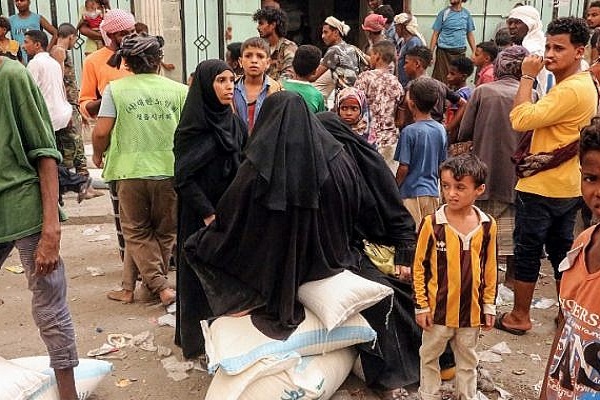For the greater part of its republican history (1962) Yemen has suffered under much violence and insecurity, plagued by recurrent and emerging armed conflicts, terrorism, radicalisation, record levels of mass displacement of population, famine and diseases.
While Yemen’s crisis is most dire, it is not isolated, rather it has become symptomatic of a wide-spread malaise. Indeed, our 21st century has been defined in violence and political instability, and as data shows, standard peace-making methods have proven ineffective at addressing such trends - &nearly half of the conflict-resolution agreements forged during the 1990s have failed within five years of their signing.
Recidivism for civil war is alarmingly high, with 90 percent of civil wars in the 2000s occurring in countries that had already experienced civil war during the previous thirty years. It is this reality all actors engaged in brokering Yemen’s peace must grapple with and more importantly still, ought to overcome. If no real solution has been brought to the table as yet it is now painfully obvious that for Yemen to attain peace and security, new thinking is needed.
As it were, Yemen’s solution may lie with the one demographic that has been systematically overlooked over the decades: women.&
Back in 2016 the World Bank estimated Yemen’s female population to represent 49.8 percent of Yemen’s total population. Today the balance is believed to have tipped in favour of women to just over 51 percent. Needless to say that by catering to only half of its demographic Yemen has functioned at a deficit - preventing any meaningful social and economic advancement.
Ignored, unrepresented, and abandoned the women of Yemen, as the song goes, have remained ‘unspoken’, and yet it is women most of all who have bore the brunt of the conflict.&
As of 2018 the United Nations established that 76 percent of internally displaced persons (IDPs) are women and children, and an estimated 3 million women and girls are at risk of gender-based violence. While only a year has passed since the publication of such numbers, women’ suffering and vulnerability have skyrocketed - spurred on by an escalation in violence as militias have pushed the boundaries of the tolerable to reinvent themselves in the unspeakable cruelty of radicalism.
While many critics will dismiss the thought of women’s socio-political engagement by arguing the need to prioritise issues of national security, I would posit that Yemen’s dismissal of women as powerful actors for change, stability and growth is what led Yemen to unravel so completely under the thumbs of armed religious ideologues.
A growing body of research suggests that women’s participation in conflict prevention and resolution advances security interests. One study found that substantial inclusion of women and civil society groups in a peace negotiation makes the resulting agreement 64 percent less likely to fail and, according to another study, 35 percent more likely to last at least fifteen years. Several analyses also suggest that higher levels of gender equality are associated with a lower propensity for conflict, both between and within states. Despite growing international recognition of women’s role in security, their representation in peace and security processes has lagged.
By strengthening women’s participation in a country such as Yemen, which suffers from a litany of overlapping and interrelating issues could allow for strides to be made towards stability as well as cementing much needed socio-economic advancement - in line with UN Security Council Resolution 1325, which formally acknowledges the benefits of women’s participation.
Several empirical analyses confirm that women offer unique, substantive, and measurable contributions to securing and keeping peace. And although traditional efforts by governments and nongovernmental organisations to combat radicalisation typically focus on reaching out to political or religious leaders - who are predominantly male &- recent research shows that antiterrorism messages are effectively disseminated throughout families and communities by women, who are well placed to challenge extremist narratives in homes, schools, and social environments, and have particular influence among youth populations.
The 2016 joint U.S. State Department-U.S. Agency for International Development (USAID) strategy to counter violent extremism around the world explicitly recognized that women’s groups can help to identify and address the drivers of violent extremism within their families, communities, and societies. &Beyond that it seems rather evident that Yemen could greatly gain by including and empowering women - to the benefit of all, including regional actors. Yemen’s future stability is just as much an issue of national security for its nationals than it is for its immediate neighbours.
&
If we consider as well that high levels of women’s participation have proven already to overwhelmingly strengthen state institutions while boosting financial growth all the while reducing levels of high poverty, Yemen absolutely ought to aggressively bridge its gender deficit - if anything to guarantee that peace will hold once it is brokered.
But minds would need reforming …
We must face the fact that Yemen’s tribal and patriarchal social norms are key factors contributing to women’s exclusion from both the political arena and the work-force.
Female access to paid employment for example has been challenged by a widely-held belief that women’s primary role is domestic, rather than academic or entrepreneurial. &Such thinking has maintained women in a state of social and political infancy, thus putting Yemen at a severe disadvantage in comparison to other countries. For example, Yemen has one of the lowest female labour force participation rates in the world, and yet it is signatory to the Convention on the Elimination of all Forms of Discrimination Against Women (CEDAW).
According to an ILO labor force survey conducted in 2013-2014, only 6 percent of women participated in the labour force prior to the conflict, while just 7 percent of jobs were held by women. Needless to say that since 2015 women have been further pushed to the edge of society - their plight heightened by radicals’ cries for absolute gender segregation.
Yemen’s future will very much depends on how its officials will shape Yemen’s peace - war after all cannot last forever. That said, to end a war does not equate to stability, and ultimately it is stability that Yemen most craves if it is to rebuild and thrive.
And until decision-makers come to terms with the fact that Yemen’s future will be most likely written by its women, I fear the impoverished nation will forever chase its tail.






التعليقات